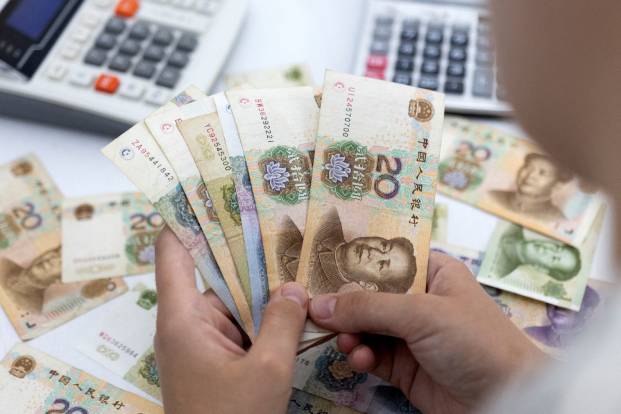China’s yuan rebounded on Thursday from a two-year low against the dollar, helped by a firmer-than-expected official guidance.
The firmer setting followed news late on Wednesday that foreign exchange regulators had phoned several banks to tell them to ease buying of the dollar.
Markets participants saw the firm setting early on Thursday as a sign officials have been increasingly uncomfortable with rapid yuan losses.
Prior to the market opening, the People’s Bank of China (PBOC) set the midpoint rate at 6.8536 per dollar, 148 pips or 0.22% weaker than the previous fix 6.8388, the softest since August 31, 2020.
But, analysts and traders said the official midpoint failed to come in as weak as they had projected, and Thursday’s guidance rate was 110 pips firmer than Reuters’ estimate of 6.8646.
“The midpoint was way beyond expectations, my feeling is that the central bank has a firm attitude in defending the currency,” a trader at a Chinese bank said.
The firmer-than-expected midpoint lifted the spot market higher. The onshore yuan rebounded from a two-year low of 6.8704 hit a day earlier to trade at 6.8532 as of 0200 GMT.
Its offshore counterpart also followed suit, bouncing from two-year lows to hit 6.8634 per dollar.
The Chinese yuan has lost about 1.6% against the dollar so far in August. While the slowing domestic economy has weighed on the local currency, the fall also comes as the US dollar has been buoyed by expectations of aggressive Federal Reserve tightening.
The move had led to some market speculation that Beijing could allow further yuan weakness to boost its vast export sector.
“The strong RMB fixing shall help dismiss the notion that a weak currency is a policy option to support growth,” Frances Cheung, rates strategist at OCBC Bank, said.
Peiqian Liu, chief China economist at NatWest, also believed that the recent yuan weakness has been mostly market-driven.
“We don’t see evidence of competitive devaluation – FX weakness likely benefits only a small proportion of China’s exports in value terms,” she said.
Liu expects the yuan to trade in a range of 6.75 to 6.95 per dollar, with risks of testing the psychologically critical 7 per dollar in coming months.
‘Ease Yuan Selling’
Sources said on Wednesday that China’s foreign exchange regulator phoned several banks to warn them against aggressively selling the Chinese currency.
The yuan’s slide in August is the steepest since April, when China cut banks’ currency reserve requirements to support the yuan.
When contacted for comment, the State Administration of the Foreign Exchange (SAFE) said markets were stable and there was no need to intervene.
“Foreign exchange expectations are stable, which helps to keep the yuan exchange rate basically stable at reasonable and balanced levels,” the SAFE said in an emailed statement.
It said the yuan remained resilient compared with other non-dollar currencies, following recent rapid dollar gains, while China‘s robust trade surplus and utilisation of foreign capital continued to play a fundamental role in stabilising cross-border flows.
Chinese state media also cited market analysts as saying that the yuan has no basis for long-term depreciation, but officials have thus far been publicly quiet on the market moves.
Controlled Depreciation
The regulator’s move suggested that yuan depreciation expectations had started to pick up, Mizuho Bank chief Asian FX strategist Ken Cheung said.
“The authorities may want to stabilise the market expectations before guiding the yuan to weaken in an orderly manner,” Cheung said.
Recent economic indicators showed that the Chinese economy is in the doldrums, with the latest alarm bell a record surge in unemployment payouts for June.
The country’s robust exports – the sole bright spot – could also face pressure from faltering global demand.
Outflows from the bond market and surprise cuts to two key interest rates last week also have put mounting pressure on the yuan, as yields and policy rates diverge from other big economies, where inflation is prompting hikes.
- Reuters, with additional editing from Alfie Habershon
Read more:
Yuan Falls Near 2-Year Low After China Cuts Lending Rates
Why China’s Yuan is Weak and May Get Even Weaker
China New Bank Loans Plunge in July, Point to Weak Second Half
























